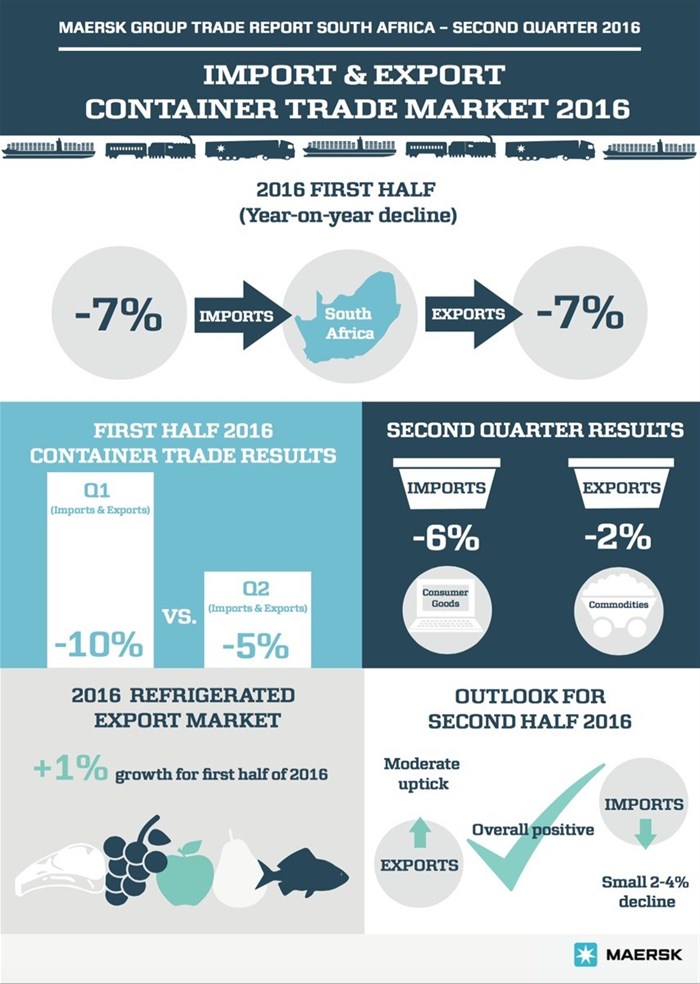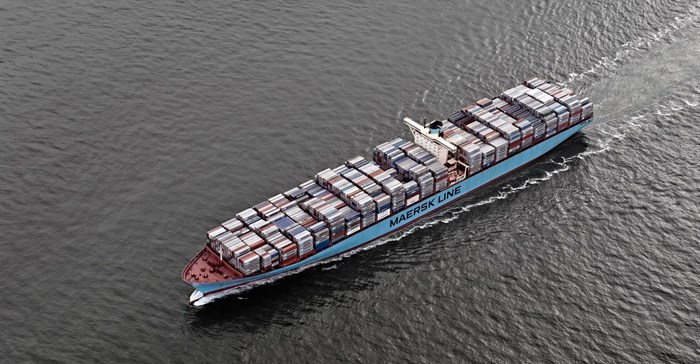According to the second quarter Maersk Trade Report, while South African container trade remains in negative territory, the second quarter of 2016 proved more encouraging than the first quarter. The report reveals the market contracted by 5% as opposed to the 10% decline reported in quarter one.
Weakened import demand
Container trade flows in and out of South Africa for the first half of 2016 showed a year-on-year decline of 7%, which Jonathan Horn, managing director of Maersk Line Southern Africa, a member of Maersk Group, attributes to a combination of reduced consumer purchasing and mining commodity demand being under pressure globally.
He explains that the Asian import market, in particular, was down, which is a sign that the weaker rand and lower consumer confidence has weakened import demand. “Largely related to the lack of available consumer spend, the imports market has been consistently under pressure each month in the first half of 2016, recording an overall drop in demand of 7% (made up of an 8% decline in quarter one, followed by a 6% decline in quarter two), with trade from Asia, South Africa’s largest importing region, dropping steeply by 13%. Other trade lanes, by large, have also slowed down in this respect, with the exception of the Middle East which has seen moderate growth over the past six months.”
Trade manager at Maersk Line Southern Africa, Matthew Conroy, mentions that one looming positive for the imports market is a small spike in demand that was noticed over July – particularly from Asia. “Although this seemingly stronger demand is encouraging for future import trade, there is a question mark in terms of its sustainability.”

Matthew Conroy
South African export market
Conroy says that South African exports in the first half of 2016 faired similarly to imports. “The exports market saw a decline of 7% year-on-year, however, in recent months the trend appears to be improving. Following the steep decline in exports of 12% over the 2016 first quarter, quarter two only saw the market contract by 2%, with marginal growth reported for June.
“The fact that the market grew in June, albeit marginally, signals some life in the South African export market. This growth is mostly on the back of rising mining commodity prices which is linked to rising China demand, specifically manganese and chrome. In particular, the quarter two selling price (versus quarter one) for manganese was up 42%, while the chrome price was up 54%.”
Dirk Hoffmann, managing director at Safmarine in Southern Africa, a member of Maersk Group, says that refrigerated exports recorded growth of 1% for the first half of 2016. “This market would have experienced more robust growth, but was hampered by the drought. However, considering that we are still in the midst of the citrus season, the full impact on the industry will not be fully known until September.”
Conroy predicts that total exports will likely see flat growth in the second half of 2016, which is a considerable improvement based on 7% market decline seen in the first half. “The export market is seeing a moderate uptick which we expect to continue for at least the next quarter. This is as a result of stronger demand for mining commodities, particularly from China, which makes up 45% of South African container exports.”

2016 Q2 Maersk Trade Report infographic
Maersk Group cautiously optimistic
Overall, the Maersk Group representatives in South Africa hold a positive outlook, saying that while South African container trade is still in a fragile position, there is definitely more optimism to be found in the market compared to three months ago, although the pace of the improvement is slow.
“In addition to the predicted moderate improvements for the export market, imports also seem to be turning a small corner based on the demand witnessed in July which has likely been further aided by the recent strengthening of the rand. However, in order to achieve sustainable economic growth, a higher level of consumer spend is necessary, which we are not yet witnessing (for example, automobile sales are still in decline). As such, for the remainder of the year, we are cautiously optimistic and anticipate a small imports market decline of somewhere around 2-4%, which is an improvement from first half 2016,” he concludes.
































